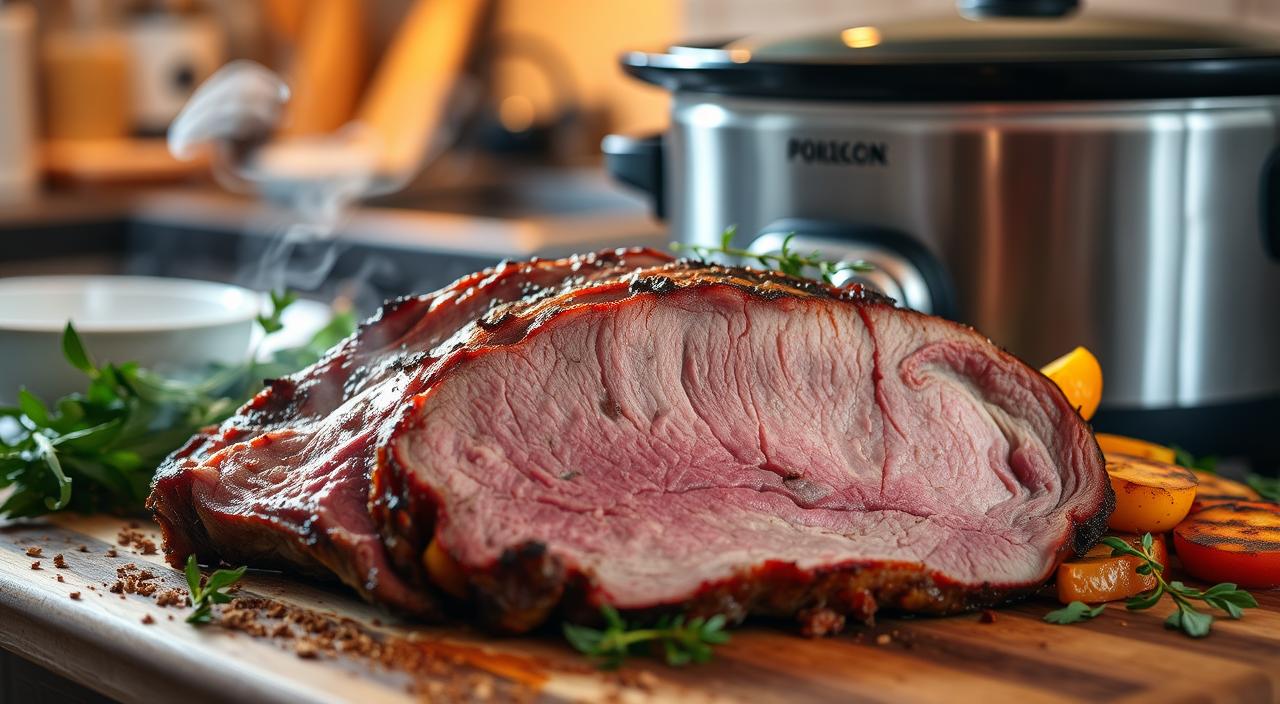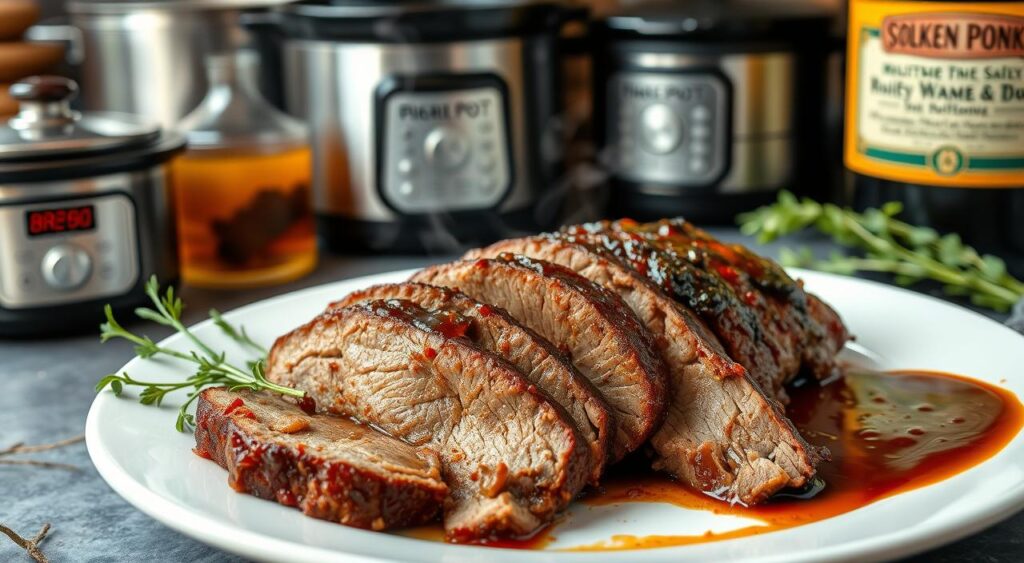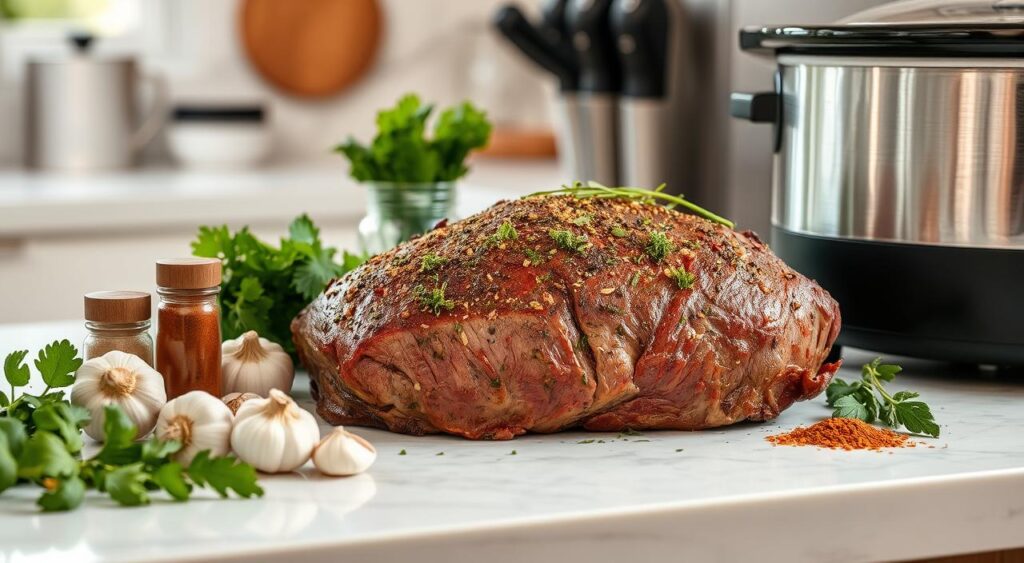Every family gathering has that one legendary dish. It turns an ordinary meal into an unforgettable experience. For many barbecue lovers, the slow cooked brisket is the ultimate goal. It’s a challenge that shows who’s a true meat master.
Turning a tough cut of meat into a tender brisket is an art. It’s not just cooking. It takes patience, skill, and knowledge of meat science.
When you master making a tender brisket, you’re doing more than cooking. You’re creating a special experience. It brings people together, starts conversations, and makes simple ingredients amazing.
Key Takeaways
- Slow cooking is essential for breaking down tough muscle fibers
- Proper temperature control determines brisket tenderness
- Fat content plays a crucial role in flavor and texture
- Marinating can enhance overall taste and moisture
- Resting the meat is as important as the cooking process
Understanding the Basics of Brisket Selection
Creating the perfect tender brisket recipe begins with picking the right meat. It’s key to choose a high-quality brisket for that tender, melt-in-your-mouth feel. This is what barbecue lovers dream of.
Choosing the Right Cut of Meat
When looking for brisket, you’ll find two main cuts: the flat and the point. A packer brisket, which has both, usually weighs 10-16 pounds. The flat is leaner and more even, while the point has more fat, making it juicier.
- Flat cut: Leaner, more uniform muscle
- Point cut: More fat marbling, juicier texture
- Packer brisket: Includes both cuts, preferred by professional pitmasters
The Importance of Fat Content
Fat is crucial in a tender brisket recipe. A good fat cap, about 1/4 inch thick, keeps the meat moist. Always cook your brisket with the fat side up to keep it juicy and flavorful.
Quality Grades and Their Impact
USDA beef grades are important for your brisket’s quality. Knowing these grades helps you pick the best meat for your recipe:
- Prime: Highest marbling, ideal for barbecue
- Choice: Good marbling, suitable for most preparations
- Select: Less marbling, may result in a drier finished product
“The right cut and quality can make or break your brisket experience.” – BBQ Experts
By choosing your brisket wisely, you’ll create a delicious, tender dish. It will impress your guests and fulfill your barbecue cravings.
The Science Behind Slow Cooked Brisket
Slow cooking brisket is a science that turns tough meat into tender goodness. Brisket is a beef cut with lots of connective tissues. These tissues need special cooking to break down.
The secret to a juicy brisket is a molecular change. Cooking it low and slow breaks down collagen into gelatin. This magic happens between 160°F and 300°F, making the meat tender.
“Patience is the secret ingredient in creating the perfect brisket.” – BBQ Pitmaster
- Collagen breaks down gradually during slow cooking
- Low temperatures help preserve meat moisture
- Extended cooking time ensures complete protein transformation
As collagen turns to gelatin, your brisket gets softer. It can soak up to 10 times its weight in liquid. This makes it incredibly juicy. Slow cooking is why brisket turns out so tender.
Pitmasters know the importance of temperature. Keeping it between 225°F and 250°F is key. It breaks down collagen well without drying the meat.
Essential Temperature Control for Perfect Results
Mastering temperature control is key to a juicy slow cooked brisket. It’s all about precision and patience. This turns a tough cut into a tender delight that wows your guests.
Optimal Cooking Temperature Range
For a tender brisket, knowing the right temperature is essential. Aim for a low temperature of 225°F to 250°F. This slow cooking breaks down the meat, making it tender.
- Ideal cooking temperature: 225°F to 250°F
- Cooking time: 1 to 1.5 hours per pound
- Target internal temperature: 195°F to 205°F
Using Meat Thermometers Effectively
A digital meat thermometer is crucial for a juicy brisket. Place the probe in the thickest part, avoiding fat. Pro tip: Always keep the thermometer clean and calibrated for precise measurements.
“Patience and precision are the secret ingredients to a perfect brisket.” – BBQ Pitmaster
Temperature Milestones During Cooking
Knowing the cooking stages is key to perfect brisket. The meat stalls at 160°F, slowing down cooking. At this point, wrapping the brisket in butcher paper helps.
- Initial cooking: 160°F – Consider wrapping
- Continued cooking: 180°F – Meat begins to tenderize
- Final stage: 195°F to 205°F – Peak tenderness achieved
Remember, every brisket is unique. Use these guidelines as a roadmap, but always trust your instincts and enjoy the cooking process!
The Art of Seasoning Your Brisket
Seasoning turns a good brisket into a truly exceptional dish. It’s all about finding the right balance of flavors. A well-made dry rub can make your brisket stand out.
Top pitmasters swear by a classic seasoning method. They use a Dalmatian rub, a mix of salt and black pepper. This is a key part of Texas barbecue.
“Great brisket starts with great seasoning” – BBQ Experts
Your brisket recipe needs a special seasoning mix. Here are the key ingredients:
- Kosher salt
- Coarse black pepper
- Garlic powder
- Paprika
- Brown sugar (optional)
Make sure to cover the brisket evenly with seasoning. This creates a flavorful crust during cooking. Adding brown sugar can make the brisket even tastier.
Pro tip: Let your seasoned brisket rest for an hour before cooking. This lets the spices soak into the meat, adding more flavor.
Mastering the Dry Rub Technique
Creating the perfect slow cooked brisket starts with a great dry rub. The right spices can turn an ordinary piece of meat into a tender delight. It’s a recipe that will wow even the pickiest barbecue fans.
Key Spice Combinations
A classic brisket rub has a basic blend that boosts flavor and makes a fantastic bark. It begins with a simple yet powerful mix:
- 50% kosher salt and black pepper
- 2 tablespoons garlic powder
- 2 tablespoons onion powder
- 1 tablespoon Gebhardt’s chili powder
- 1/2 teaspoon cumin
Dry Brining Process
The dry brining technique is key for a tender brisket. Rub the meat with 1/3 to 1/2 cup of seasoning all over. Let it rest for hours, so the spices soak deep into the meat.
Pro tip: Avoid adding moisture like mustard, which can interfere with bark formation.
Application Methods
When rubbing your brisket, make sure to cover it evenly. Rub the spices into every part, including the sides. Aim for a thick, even layer for a great crust during cooking.
About 40% of brisket lovers say the rub is crucial. Take your time and rub it well to improve your barbecue skills.
The Role of Moisture in Brisket Cooking
To make a juicy slow cooked brisket, you need to manage moisture well. The tenderness and taste of your brisket depend on controlling moisture from the start to the end.
Moisture is key in making a tough piece of meat into a delicious dish. When cooking brisket, focus on a few important steps to keep it moist:
- Use a water pan in your cooking environment
- Spritz the meat periodically during cooking
- Consider wrapping techniques to retain internal moisture
- Monitor internal temperature carefully
The stall period is a critical time when moisture evaporation slows down the temperature rise. Keep the heat and humidity steady during this time to avoid drying out the brisket.
“The secret to a perfect brisket is understanding how moisture moves through the meat during cooking.” – BBQ Pitmaster
Wrapping methods greatly affect your juicy slow cooked brisket. Butcher paper lets smoke in while keeping moisture in, making the meat tender. Aluminum foil works too but might soften the bark. Choose your wrapping method carefully.
Keep the internal temperature between 200-205°F and let it rest properly. This ensures the juices are evenly distributed, making the brisket delicious.
Traditional Texas-Style Preparation Methods
Texas-style brisket is a true art form. It turns a tough cut into a tender, flavorful dish. The secret lies in the perfect mix of cooking and flavor.
Smoking vs. Oven Roasting
There are two main ways to cook a tender brisket: smoking and oven roasting. Smoking gives a true Texas taste. Oven roasting is easier for home cooks.
- Smoking method requires 12-16 hours of cooking
- Oven roasting can be completed in 6-8 hours
- Both methods target an internal temperature of 195°F-205°F
Wood and Smoke Flavor Profiles
The wood you choose greatly affects your brisket’s taste. Texas pitmasters often use hickory and oak. These woods give a deep, rich smoky flavor.
“The wood is as important as the meat itself in creating an authentic Texas brisket experience.” – Texas BBQ Expert
Regional Variations
Brisket preparation varies across Texas. Central Texas likes simple salt and pepper. East Texas uses sweeter, more complex seasonings.
- Central Texas: Minimalist SPG (Salt, Pepper, Garlic) rub
- East Texas: More elaborate spice blends
- West Texas: Slightly different smoking techniques
For a great brisket, patience and proper temperature control are key. Respect the meat’s natural taste is also crucial.
Resting and Slicing Techniques
Getting the final steps right for a juicy slow cooked brisket is key. After hours of cooking, your brisket needs a good rest. This ensures it stays flavorful and moist.
The resting time is not just waiting. It lets the meat’s juices spread evenly. This makes the brisket more tender and juicy. Experts say to rest your brisket for 1 to 3 hours after cooking.
“Patience is the secret ingredient to a perfectly tender brisket.” – BBQ Pitmaster
When slicing, being precise is important. Here are some tips:
- Identify the meat’s grain direction carefully
- Use a sharp knife for clean cuts
- Slice against the grain for maximum tenderness
- Keep slices thin – no wider than a pencil (about 0.2 inches)
Notice the brisket’s two main parts:
- The flat: Larger and leaner cut
- The point: Smaller and fattier section
Each part has its own grain direction. Adjust your slicing method for each. By using these techniques, you’ll make your slow-cooked brisket tender and juicy. It will impress BBQ lovers everywhere.
Common Mistakes to Avoid
Making a tender brisket recipe needs care and patience. Many home cooks make mistakes that can ruin a good brisket. This turns it into a tough, disappointing dish.
Here are the most common mistakes to avoid during brisket preparation:
- Temperature Control Errors
- Cooking at temperatures that are too high
- Not keeping the heat steady throughout cooking
- Not using a reliable meat thermometer
- Timing Miscalculations
- Rushing the cooking process
- Not giving enough cooking time (usually 12-16 hours)
- Cutting the brisket too soon after cooking
“Patience is the secret ingredient in any successful brisket recipe.” – BBQ Pitmaster
Slicing technique is also key. Always slice against the grain for tenderness. Your slow cooked brisket should be easy to pull apart with a fork but still hold together.
Here are some tips to avoid mistakes:
- Watch the internal temperature (aim for 195°F)
- Let the brisket rest for at least one hour after cooking
- Keep the fat cap on during cooking
- Use little spritzing to avoid messing with fat rendering
By knowing these common mistakes, you’ll get better at making a tender brisket every time.
Conclusion
Making the ultimate juicy slow cooked brisket is a journey. It needs patience, precision, and passion. You must understand key techniques to turn tough meat into a tender delight.
Start with high-quality USDA Choice or Prime grade meat. Keep the temperature steady between 225°F to 275°F. This breaks down the meat’s connective tissues, making it tender.
Cooking time depends on the brisket’s weight. It usually takes 1 to 1.5 hours per pound. Aim for an internal temperature of 200-205°F for the best tenderness.
Preparation and resting are crucial. Let the meat rest for at least 30 minutes after cooking. This lets the juices spread, improving flavor and tenderness.
Slice against the grain and baste every 30 minutes for extra flavor. With practice, you’ll make a brisket as good as a restaurant’s in your kitchen. Be sure to incorporate these new skills into recipes such as sandwiches, chili, and tacos.
Be open to trying new seasoning techniques and approaches. Each brisket you make will teach you something new. Your skills will grow with each attempt, leading you to brisket perfection.
FAQ
What makes a brisket tender?
A tender brisket comes from slow cooking at low temperatures. This breaks down tough tissues and turns collagen into gelatin. Key factors include choosing a well-marbled cut, seasoning right, keeping temperatures low, and cooking for a long time.
How long should I cook a brisket?
A slow-cooked brisket takes about 1 to 1.5 hours per pound at 225-250°F. A 10-pound brisket might need 10-15 hours to get tender. This time varies based on your cooking method and equipment.
What is the best cut of brisket for slow cooking?
Choose a full packer brisket with good marbling, like USDA Prime or Choice. The point cut is more flavorful, while the flat cut offers consistent slices. Good fat content is key for a juicy brisket.
Should I wrap my brisket during cooking?
Wrapping helps keep moisture in and prevents drying. The Texas Crutch method uses butcher paper or foil to retain moisture and speed up cooking.
What temperature should I cook brisket to?
For a tender brisket, aim for 195-205°F. The meat should reach this temperature slowly, allowing collagen to break down. Use a meat thermometer to check the temperature accurately.
How do I prevent my brisket from becoming dry?
To keep it moist, try spritzing, using a water pan, and keeping temperatures low and steady. Letting the brisket rest after cooking is also crucial. Resting helps juices spread evenly, making the brisket juicy.
What are the best seasonings for brisket?
A classic dry rub includes kosher salt, black pepper, garlic powder, and paprika. Some add cayenne, brown sugar, or other spices. The goal is to enhance the beef flavor without overpowering it.
How should I slice a brisket?
Always slice against the grain with a sharp knife. Cut perpendicular to the muscle fibers. This makes each slice tender and easy to chew, enhancing your brisket’s enjoyment.



